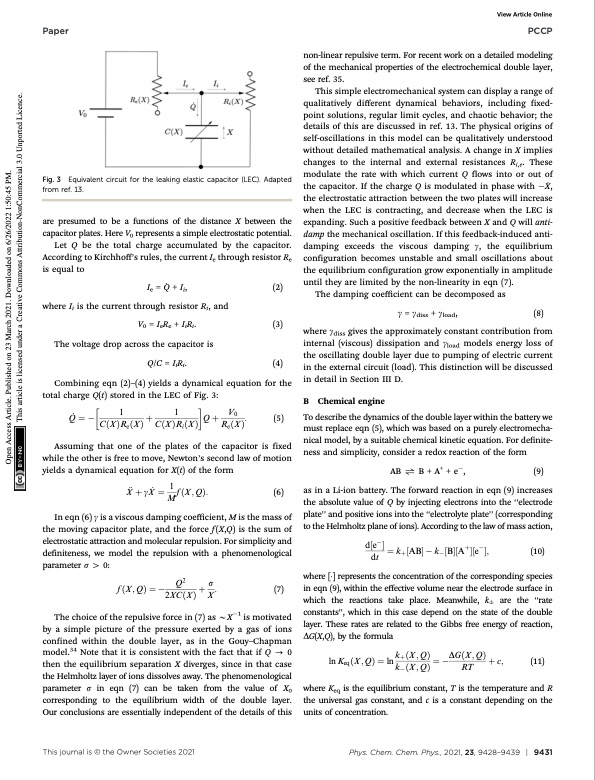
PDF Publication Title:
Text from PDF Page: 004
Paper PCCP non-linear repulsive term. For recent work on a detailed modeling of the mechanical properties of the electrochemical double layer, see ref. 35. This simple electromechanical system can display a range of qualitatively different dynamical behaviors, including fixed- point solutions, regular limit cycles, and chaotic behavior; the details of this are discussed in ref. 13. The physical origins of self-oscillations in this model can be qualitatively understood without detailed mathematical analysis. A change in X implies changes to the internal and external resistances Ri,e. These modulate the rate with which current Q flows into or out of the capacitor. If the charge Q is modulated in phase with X:, the electrostatic attraction between the two plates will increase when the LEC is contracting, and decrease when the LEC is expanding. Such a positive feedback between X and Q will anti- damp the mechanical oscillation. If this feedback-induced anti- damping exceeds the viscous damping g, the equilibrium configuration becomes unstable and small oscillations about the equilibrium configuration grow exponentially in amplitude until they are limited by the non-linearity in eqn (7). The damping coefficient can be decomposed as g = gdiss + gload, (8) where gdiss gives the approximately constant contribution from internal (viscous) dissipation and gload models energy loss of the oscillating double layer due to pumping of electric current in the external circuit (load). This distinction will be discussed in detail in Section III D. B Chemical engine To describe the dynamics of the double layer within the battery we must replace eqn (5), which was based on a purely electromecha- nical model, by a suitable chemical kinetic equation. For definite- ness and simplicity, consider a redox reaction of the form AB"B+A+ +e, (9) as in a Li-ion battery. The forward reaction in eqn (9) increases the absolute value of Q by injecting electrons into the ‘‘electrode plate’’ and positive ions into the ‘‘electrolyte plate’’ (corresponding to the Helmholtz plane of ions). According to the law of mass action, d1⁄2e1⁄4k 1⁄2ABk 1⁄2B1⁄2Aþ1⁄2e; (10) dtþ where [] represents the concentration of the corresponding species in eqn (9), within the effective volume near the electrode surface in which the reactions take place. Meanwhile, k are the ‘‘rate constants’’, which in this case depend on the state of the double layer. These rates are related to the Gibbs free energy of reaction, DG(X,Q), by the formula ln KeqðX; QÞ 1⁄4 ln kþðX; QÞ 1⁄4 DGðX; QÞ þ c; (11) kðX;QÞ RT where Keq is the equilibrium constant, T is the temperature and R the universal gas constant, and c is a constant depending on the units of concentration. Equivalent circuit for the leaking elastic capacitor (LEC). Adapted from ref. 13. are presumed to be a functions of the distance X between the capacitor plates. Here V0 represents a simple electrostatic potential. Let Q be the total charge accumulated by the capacitor. According to Kirchhoff’s rules, the current Ie through resistor Re View Article Online Fig. 3 is equal to Ie = Q: + Ii, where Ii is the current through resistor Ri, and (2) V0 = IeRe + IiRi. (3) The voltage drop across the capacitor is Q/C = IiRi. (4) Combining eqn (2)–(4) yields a dynamical equation for the total charge Q(t) stored in the LEC of Fig. 3: _ 1 1 V0 Q 1⁄4 CðXÞReðXÞ þ CðXÞRiðXÞ Q þ ReðXÞ: (5) Assuming that one of the plates of the capacitor is fixed while the other is free to move, Newton’s second law of motion yields a dynamical equation for X(t) of the form X€þgX_ 1⁄4M1fðX;QÞ: (6) In eqn (6) g is a viscous damping coefficient, M is the mass of the moving capacitor plate, and the force f (X,Q) is the sum of electrostatic attraction and molecular repulsion. For simplicity and definiteness, we model the repulsion with a phenomenological parameter s 4 0: Q2 s f ðX; QÞ 1⁄4 2XCðXÞ þ X: (7) The choice of the repulsive force in (7) as BX1 is motivated by a simple picture of the pressure exerted by a gas of ions confined within the double layer, as in the Gouy–Chapman model.34 Note that it is consistent with the fact that if Q - 0 then the equilibrium separation X diverges, since in that case the Helmholtz layer of ions dissolves away. The phenomenological parameter s in eqn (7) can be taken from the value of X0 corresponding to the equilibrium width of the double layer. Our conclusions are essentially independent of the details of this This journal is © the Owner Societies 2021 Phys. Chem. Chem. Phys., 2021, 23, 9428–9439 | 9431 Open Access Article. Published on 23 March 2021. Downloaded on 6/26/2022 1:50:45 PM. This article is licensed under a Creative Commons Attribution-NonCommercial 3.0 Unported Licence.PDF Image | Dynamic theory battery electromotive force

PDF Search Title:
Dynamic theory battery electromotive forceOriginal File Name Searched:
d1cp00196e.pdfDIY PDF Search: Google It | Yahoo | Bing
Sulfur Deposition on Carbon Nanofibers using Supercritical CO2 Sulfur Deposition on Carbon Nanofibers using Supercritical CO2. Gamma sulfur also known as mother of pearl sulfur and nacreous sulfur... More Info
CO2 Organic Rankine Cycle Experimenter Platform The supercritical CO2 phase change system is both a heat pump and organic rankine cycle which can be used for those purposes and as a supercritical extractor for advanced subcritical and supercritical extraction technology. Uses include producing nanoparticles, precious metal CO2 extraction, lithium battery recycling, and other applications... More Info
| CONTACT TEL: 608-238-6001 Email: greg@infinityturbine.com | RSS | AMP |